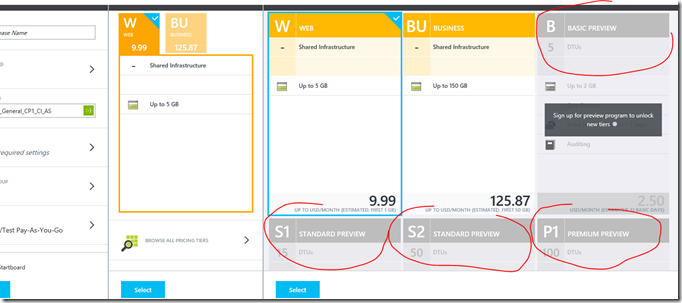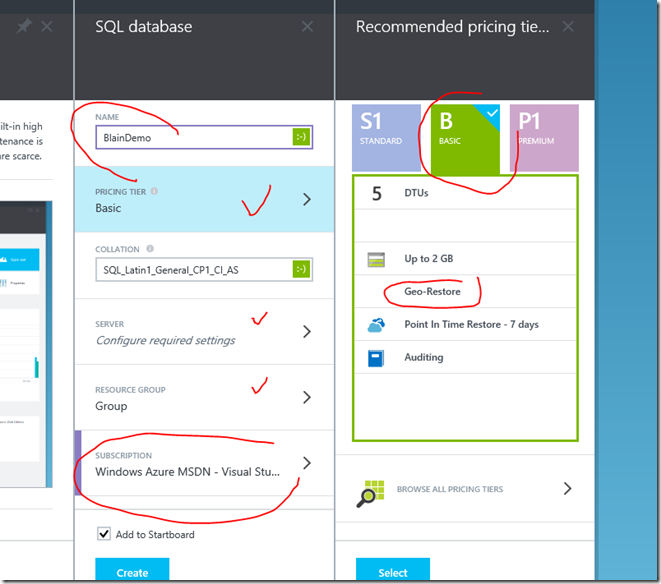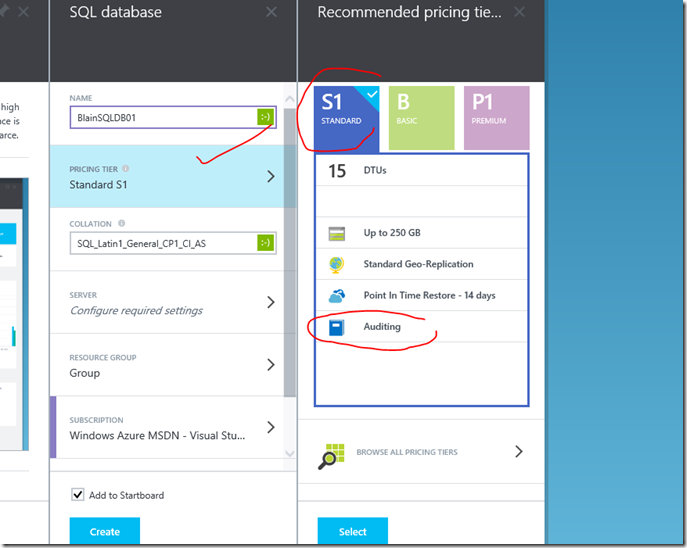Step-By-Step- Azure SQL Database introduces geo-restore, standard geo-replication, and auditing -
Check out the Microsoft Azure Blog and the Azure SQL Database Business Continuity, Preview features, and Changing Database Service Tiers and Performance Levels webpages.
Microsoft has added some new SQL Database features that include -
- Geo-restore
- Standard geo-replication
- Auditing
While exploring these features, I put together some information to help guide you through,
In the new Preview Portal select Data, storage, cache. + backup,
You need to turn-on the Preview Features you want to use-
To unlock the new tiers, you need to sign Up for the Preview Features you want -
Pick the subscription you want to use, in this case I’m using my Windows Azure MSDN – Visual Studio Ultimate Subscription -
In the current portal, select the PREVIEW EDITION for Basic, Standard or Premium under your MSDN subscription.
Select NEW and you will see the SQL choices-
If you are a BizSpark enrollee you have all these benefits, so go to https://aka.ms/try-azure
Select this option under your MSDN subscription and then select your Preview Edition.
In the Preview Portal select go to Data, storage, cache. + backup and select SQL database to see the same choices.
Geo-restore is designed for emergency data recovery when you need it most, geo-restore recovers a database to any Azure region in the event of a catastrophic event. Geo-restore uses geo-redundant Azure Blob storage for daily database backups and is available with Basic, Standard, and Premium tiers in the current Azure Management Portal and standard API.
Standard geo-replication asynchronously replicates a secondary database that’s ready to take over if disaster strikes. Azure regions are pre-paired, at least 500 miles apart, and within geopolitical areas to help ensure data sovereignty. Standard geo-replication is available with Standard and Premium databases in the current Azure Management Portal and standard APIs. Standard geo-replication incurs a cost for the secondary database, which is billed at 75 percent of the primary database.
Here’s a look at the database selections under the new Preview Portal.
Auditing tracks and logs events that occur on your database. Dashboard views and reports provide at-a-glance insight into database events. Use auditing to streamline compliance-related activities, stay informed about what’s happening in your database, and identify trends, discrepancies, and anomalies like business concerns or suspected security violations. Audit events are written to an audit log that is stored in an Azure storage account that you designate (note that Azure storage rates apply). Auditing is available in Basic, Standard, and Premium tiers and only available in the new Azure preview portal and via standard APIs.
This feature is available in the Preview Portal as well,
Microsoft also improved the billing experience for Premium tier customers using active geo-replication. Now, every Premium secondary replica will be clearly designated in your bill as “secondary.”
For a comprehensive look pricing, visit the SQL Database Pricing Details webpage.
Once again, for more information, check out the Microsoft Azure Blog and the Azure SQL Database Business Continuity, Preview features, and Changing Database Service Tiers and Performance Levels webpages.
For your 30-day trial of Microsoft Azure go to: https://aka.ms/try-azure
For your free training resources make sure and visit the Microsoft Virtual Academy at https://aka.ms/go-mva
Don’t forget SQL PASS Summit in Redmond Washington, November 4 –7, 2014











